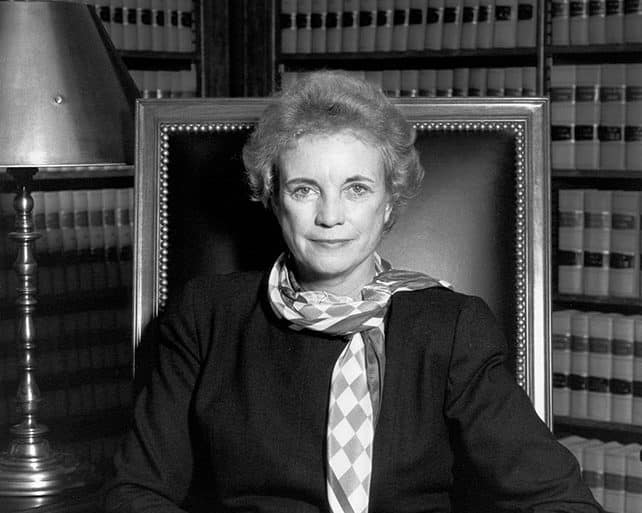This morning, I received a news alert that Sandra Day O’Connor, the first woman to serve on the United States Supreme Court, died today at age 93 from complications of dementia. Justice O’Connor was considered the most powerful woman in America for many years of her service on the bench. Serendipitously, yesterday I read an Exponent II https://exponentii.org/wp-content/uploads/2021/12/IMG_5173-scaled-1.jpgial by Sue Paxman (now Booth-Forbes) from 1994 when Justice O’Connor gave the commencement address at BYU’s graduation. She advised the graduates that as they structure their lives and relationships, they look at building the structures to make certain that the women among them achieve their potential and make their contributions. This wise counsel is still needed, so I share the https://exponentii.org/wp-content/uploads/2021/12/IMG_5173-scaled-1.jpgial here. If you have reflections on Justice O’Connor, please leave them in the comments.
***
“Adding Another Floor”
By Sue Paxman
This past August brought my family the joyful chance to watch our daughter graduate from BYU. And a great time was had by all. There’s nothing quite like spending a brilliantly lit, blue-skied day next to those mountains—taking pictures of loved ones smiling with pride—to lift your heart and help you believe in the future. Holding her BYU degree in front of her, she stood in the center of those pictures, her face shining with relief, gratitude, pride, and expectation.
An unexpected highlight to our week of graduation celebration was Supreme Court Justice Sandra Day O’Connor’s commencement address. She began by recalling her own graduation from Stanford Law School in 1952 and the reality that the only job offer she received from the private sector was as a legal secretary. She went on to say that in that same year Adlai Stevenson gave the commencement address at Smith College where he encouraged the graduates to be proud of their accomplishments and to use the education that they had just completed to influence their husbands and sons to influence the world, Justice O’Connor finished her story by saying, “Isn’t it wonderful that that address will never again be given in the United States? Today, young women are expected to have, and do have, a direct influence on public affairs. There are more women in public office, in state and national legislative positions, than ever before and there are more women candidates for public office at all levels of government than ever before in our history.”
Continuing with this theme and speaking from her own experience, O’Connor told the 2,428 graduates, 1,137 of whom were women that it is now possible to choose from a wide variety of paths.
“As students today, your challenges will come not so much in breaking new paths as your mothers, grandmothers, and I have done but in deciding which of the many paths now open you should choose from. As far as I’m concerned, it is worth every bit of the extra effort I put into it to have a family as well as a career. . . . As for women today, the tide is running in your favor; the wind is at your back.”
She then went on to discuss some of the adjustments that we as a society must make in order for women to reach their potential, to make the best use of their talents, to contribute to the larger good. To clarify her point, she told a story about a university in the Boston area that decided to expand its science building by adding a third floor. During construction, an engineer from his office in the building next door observed that if the addition continued as planned it would crush the bottom two floors. The building as designed could not bear the extra weight. Upon the engineer’s suggestion, the architects reworked their plans. The third floor was extended out beyond the rest of the building by five feet on all four sides, and pillars were placed under the overhang to provide the extra support that was needed. As Justice O’Connor pointed out, although the building didn’t look like the original design had indicated it would, it was a strong, sound structure, and as an added bonus, it provided more space than was originally intended.
So too, she advised, should we look to the way we structure our lives and the relationships in which we engage, and she admonished the graduates to look at how they can change those structures to make certain that the women among them achieve their potential and make their contribution. As she made clear in her concluding remarks, our society and our economy need the best from all of us. Rethinking and redesigning the structures that we build to help us get our work done, relate to each other, and be of service is worth all our best efforts.
Justice O’Connor wished the graduates well as they looked forward to expanding the structure of their families and asked them to remember that with the proper support any structure, no matter how unique the design, will stand and accomplish even, perhaps, expand its original purpose.
The several young women graduates that I talked to afterward were thrilled. One of the most influential role models for women in this country had just given them wonderful new insights on how to approach the days ahead. With joy, they felt they could look to the challenges of the future confident that they would find the resources and support to meet those challenges.
In this issue, you will find several articles written by and for single Mormon women. Our hope is that the voices speaking here offer the kinds of insight and support that will help us create the new kinds of family and relationship structures that Justice O’Connor described as possible. We belong to a church and a culture that places high value on families and the love and support that family units give to individual souls. Let’s listen to the voices in this issue and work together to be certain that they are not only heard but that they are part of what we consider and value as we build the families of our future.
***
Feature image of Justice Sandra Day O’Connor © Toshi Kazama





